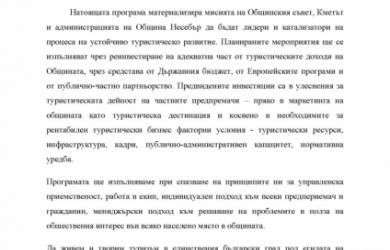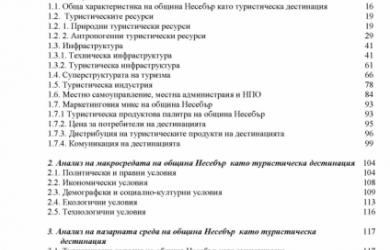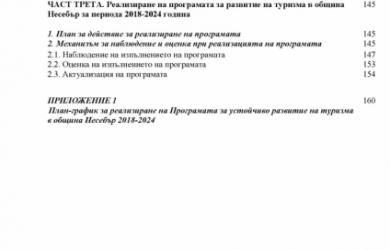Tourism and Cultural Heritage
Authors: Sonia Aleksieva, Irena Bokova
FOREWORD
The book Tourism and Cultural Heritage offers different insights into the major topic that has changed Bulgaria’s image as a tourist destination over the past decade: cultural tourism. It is part of the expectations of both experts and tourists that the country’s potential of offering various types of cultural tourism could become a competitive product in the European marketplace.
Bulgaria’s priorities as a tourist destination featuring recognized cultural and natural heritage include increased attention to the preservation and safeguarding of tangible and intangible cultural heritage, according to the terminology used by international organizations, growing investment in up-to-date, modern infrastructure to ensure access, as well as knowledge, quality education, and professional training. This has become an imperative of the strategy and guidelines for sustainable development of Bulgarian tourism, according to Bulgarian politicians, incumbents, and experts in the field, and also in the light of the strong competition in the global tourism marketplace. In a time of dynamically changing customer profile and attitudes, the requirements toward the preservation of traditions, the activities of cultural institutions and the organization of tourist attractions are all focused on one major issue: the quality of the tourist product offered, from the viewpoints of economists, advertisers, and PR professionals. In the context of dramatic change in lifestyles, respectively of cultural transformations, and the trends towards the globalization of cultures, the relationship between hosts and visitors has become a crucial one: it is a matter of developing tourism as discovery and exchange between people and cultures. Therefore, the book examines cultural tourism from different viewpoints and as a field of activity which needs that partnerships and co-operation be built, sustained, and constantly rearranged.
The purpose of this book is to present research and analyses on the one hand and, on the other hand, to provide examples of how Bulgaria’s rich cultural heritage, museums, cultural landscapes, and tourist attractions as a ‘visible’ part of culture and history can generate image, recognisability, economic success, and positive social effect for the country through tourism. It is through these examples that answers are sought to the questions of how facts are communicated by popularizing contemporary cultural events; how the variety of cultural products are socialized; how Bulgaria could draw a true self-confidence from its changing image as a EU member.
This reality in the development of Bulgarian cultural tourism from heritage to attractions and from museums to folklore is laid out by the authors in the book’s ten chapters on the basis of field research and analysis of international and national initiatives and projects. The extremely live issues brought up in the book are a continuation of cultural debates and increased public interest for questions related to historical memory, changes in museums and galleries, and the ‘authenticity of Bulgarian tradition’, its development, and transformation into cultural heritage. However, the authors do not always answer these difficult questions but provoke answers through facts: do the government, society, businesses, experts, managers, local communities etc. consider rethinking cultural heritage, the vision of cultural institutions, and the dialogue on culture as a developmental resource?
The texts proposed present, analyse, and discuss real world results of the development of various types of cultural tourism in the country in recent years. As researchers and teachers on the one hand and as initiators and participants in many projects on the other hand, the authors identify the trends, success stories, problems, possible tensions, and conflicts in cultural tourism practices. They follow-up the progress of ideas, initiatives, and projects in the field of cultural tourism and cultural heritage at various institutions, organizations, and museums in Plovdiv, Ruse, Veliko Tarnovo, Sofia, Smolyan, Ivaylovgrad, Zlatograd, Gabrovo, Burgas, Etara Open Air Museum, Velingrad, and Malko Tarnovo. Interesting parallels are drawn with the activity of cultural institutions, non-governmental organizations and municipalities in Italy, the Netherlands, France, Turkey, and China. For the first time, a similar research has given special attention to the results of applied scientific joint projects implemented by the authors together with their colleagues and students from the New Bulgarian University, in cooperation with Bulgarian and European partners in the fields of tourism, higher education, life-long learning, culture, and local development.
The strong practical applied aspect of the book results from the presentation of good practices in cultural tourism, new viewpoints and approaches to cultural heritage and cross-cultural differences through the prism of anthropology, knowledge building, interpretation of cultures as a lifestyle that is meaningful to both hosts and visitors, and interesting ideas generated in the field of research and popularization of Bulgarian history and culture. The synergy of two apparently different but mutually complementary viewpoints of the subject is due to the experience and practice of the two authors one of whom is a researcher and expert in anthropology and the other an expert in cultural tourism and public relations. The authors share researcher reflexion and expert opinions, analysing international and national policies related to cultural tourism and cultural heritage, and pointing out to the need of new approaches to the understanding and planning of cultural tourism with emphasis on its social dimension and modern management.
In the context of the various topics, each part contains additional practical information, a terminological glossary, and useful links to other data sources. In addition to the authors’ texts, there is an Annex offering a substantial collection of documents and illustrations about artefacts, special events, and exhibitions. Many of the photographs are published for the first time and add value to the natural narrative transforming it into a written history of institutions and people who made Bulgaria believe that the era of mass tourism has long been over.
The book is aimed at a large audience: all those who have professional interest for cultural tourism development or are sensitive to Bulgaria’s cultural heritage and the possibility for its popularization throughout the country and its becoming a sign of cultural richness and part of the world cultural heritage; experts and those working to make cultural tourism become a resource for local development; trainees and students of cultural tourism-related professions; researchers and specialists in the field of public policies and management… Therefore, the authors propose that basic theoretic concepts and directions of research be introduced, build their analyses and reflexions on case studies, and share observations and experiences from their activity as experts and participants in national and international projects.
The book’s message is clear and straightforward: the chances of change reside in positioning the country as a year-round tourist destination, featuring a rich cultural and historical heritage, offering a diverse four-season tourist product, and seeking to preserve, exhibit, and share its culture and nature. This change that not everybody can understand, see, and appreciate is what the book is all about. It has been written with much gratitude and respect for all those who acknowledge the cause and work for it: the renown of Bulgaria as a European tourist destination lies in the future of cultural tourism.
The authors





